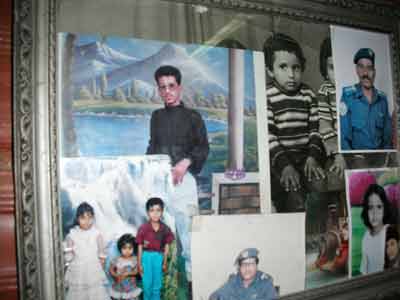
Sunday,
June 03, 2007
Vol.
42 - No 01
Photo exhibit gives glimmer of hope to Guantanamo detaineesSnapshots of homeBy Juan A Lozano
HOUSTON (AP) - At first glance, the photographs seem simple. A Dairy Queen in Bahrain. Three daughters in Yemen holding up paper flowers made by their father. Snowcapped mountains in the Afghan countryside that seem to belong in a vacation scrapbook.The photos were the work of attorneys representing detainees at Guantanamo Bay Naval Base, where about 380 people are being held on suspicion of links to al-Qaeda or the Taliban. The pictures were taken during trips lawyers made to the prisoners' countries and capture images of them interacting with their clients' families.They also offer reminders of home as landscapes or snapshots of a living room or favourite restaurant. Eighty-eight of these photographs, which document the trust that grew between detainees and their attorneys, are on display in an exhibit at Fotofest called "Guantanamo. Pictures From Home. Questions of Justice."Photographer Margot Herster, who helped put the show together, started gathering the images when her husband's law firm, Allen & Overy, represented 11 detainees from Yemen at the military detention center in southeastern Cuba. She was spurred on by a growing curiosity about the men that her husband Scott Sullivan would visit."It's a slice of what's going on in Guantanamo from the perspective of this relationship that had developed between the attorneys and the detainees," Herster said. All detainees are classified as "enemy combatants" - a status that accords them fewer rights than prisoners of war under international law. Most have been held for years without charges."Bringing a picture of us standing next to their father in their living room, that really solidified the idea their family was behind this and we are who we say we are," said Doug Cox, who along with Sarah Havens, works for Allen & Overy, based in London. The exhibit, Herster said, was also designed to counter the common image of Guantanamo Bay: images of detainees in orange jumpsuits herded around by U.S. soldiers."You take them on a one-to-one basis and (the exhibit) gives you an idea about who these people really are," Cox said. None of the photographs in the show, which centers on 32 detainees, were taken at Guantanamo. They were shot by the lawyers during trips to their client's home countries - Afghanistan, Bahrain, Kuwait, Saudi Arabia and Yemen. The photos are accompanied by text of interviews with the attorneys as well as excerpts from military tribunals at Guantanamo.The exhibit also features several short videos family members made, telling the prisoners to trust their attorneys, as well as a 15-minute film in which the lawyers discuss their experiences. Another section of the exhibit is mounted with the audio in a darkened room, made to resemble the isolated environment at Guantanamo.Although the photos are simple, the images offered the prisoners a chance to reconnect with their lives, as many had not seen their relatives or homes in years. Some of the detainees became obsessed with the photographs, learning every detail and sharing the images with other prisoners.A photograph of detainee Abdulaziz al Swidi's three daughters in Yemen, holding up paper flowers, let al Swidi know the girls had received his gift for them - flowers he had made from toilet paper at Guantanamo. A more abstract photo featured a pair of gold earrings that al Swidi's attorneys, Cox and Havens, gave to his mother for him. It was accompanied by a note in Arabic that read, "Don't despair, someone in the sky is taking care," a phrase al Swidi's mother used to tell him.The image of a Dairy Queen in Bahrain reminded detainee Isa al Murbati of trips he and his family used to make. In two other photos, nieces and nephews for detainee Abdullah al Anazi, from Saudi Arabia, hold up his Guantanamo mug shot; his favorite clothes - a gray soccer shirt and white athletic pants - hang outside a closet in his room.Other photos are more picturesque reminders of home, offering views of crowded downtown Kabul, Afghanistan, and a small village within a green valley in Yemen. Herster said she wasn't necessarily trying to make a political statement about Guantanamo with the exhibit or make judgments on guilt or innocence."Guantanamo is something the public is very ambivalent about. We are torn between national security and the ideals of justice that we are used to. I was hoping the stories and images would create an entryway to wanting to understand more," Herster said. For Havens, the photographs have became much more than a byproduct of her legal efforts."Part of the project of Guantanamo for the government is to erase these people's identities," she said. "These photos are valuable because they remind them they have a history and have a place in life." The exhibit, sponsored by FotoFest, a nonprofit photographic arts and education organization, will be on display through June 2. Part of the exhibit will be displayed in New York City next month. |
|| Front
Page | News | Editorial | Columns | Sports | Plus | Financial
Times | International | Mirror | TV
Times | Funday
Times || |
| |
Copyright
2007 Wijeya
Newspapers Ltd.Colombo. Sri Lanka. |
